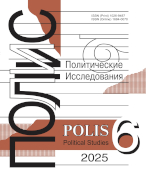Chinese Foreign Policy Reflected in Images of the Present and the Future:
Psychographic Method
Tokarev A.A.,
MGIMO University, Moscow, Russia, a.tokarev@inno.mgimo.ru
elibrary_id: 637634 | ORCID: 0000-0002-8196-0518 | RESEARCHER_ID: AAD-3009-2020
Prikhodchenko A.Yu.,
MGIMO University, Moscow, Russia, prikhodchenko.a.yu@my.mgimo.ru
ORCID: 0000-0001-5043-6708 |Margoev A.R.,
MGIMO University, Moscow, Russia, a.margoev@inno.mgimo.ru
elibrary_id: 933344 | ORCID: 0000-0002-3349-6941 |
Tseleshchev A.A.,
MGIMO University, Moscow, Russia, alexey.tseleshchev@mail.ru
ORCID: 0000-0002-9430-5707 |DOI: 10.17976/jpps/2021.01.05
Tokarev A.A., Prikhodchenko A.Yu., Margoev A.R., Tseleshchev A.A. Chinese Foreign Policy Reflected in Images of the Present and the Future: Psychographic Method. – Polis. Political Studies. 2021. No. 1. https://doi.org/10.17976/jpps/2021.01.05
This work was supported by the Russian Science Foundation, project No. 19-78-10144. The authors are grateful for help with the text to MGIMO students A.V. Fedotov and I.Yu. Shchedrov.
This article is the first attempt in the field of Chinese studies in Russia to apply the psychographic method to the study of Chinese society. The article considers the way Chinese citizens imagine the present and the future of their own country. During November-December 2019, when study was conducted by the authors, a database of 189 drawings was created, from which 785 images were extracted. These images were classified among 14 categories (“nature”, “war”, “culture”, etc.). The study shows that PRC citizens have high expectations of their future standards of living, strong faith in successfully resolving ecological problems, and concerns about China’s ageing population. Contrary to the expectations of the authors, images directly associated with socialism or communism are absent. The article concentrates on China’s image in the international arena and the role of Sino-Russian relations. Chinese citizens portray China as having tremendous potential and being supreme to other counterparts, while remaining a peaceful state. Russia does not play a key role, but is mentioned as an important geopolitical player and China’s partner (not ally). The study reveals a discrepancy between the images regarding China’s role in the world and verbal explanations thereof. Subconsciously, the respondents portray China as more powerful than other countries, yet at the same time deny the assumption that China is aspiring to become “number 1”. The same can be said about the image of Russia: respondents notice the importance of relations between the two countries, but in most drawings, Russia is depicted in the same way as other neighbors of China.
References
Callahan W.A. 2010. China: The Pessoptimist Nation. N.Y.: Oxford University Press. 266 p.
Feng H., He K., Li X. 2019. How China Sees the World: Insights from China’s International Relations Scholars. London: Palgrave Macmillan. 143 p.
Friend J.M., Thayer B.A. 2018. How China Sees the World: Han-Centrism and the Balance of Power in International Politics. Lincoln: Potomac Books. 191 p.
Jacques M. 2012. When China Rules the World: The Rise of the Middle Kingdom and the End of the Western World. London: Penguin Books. 848 p.
Nathan A.J., Scobell A. 2012. How China Sees America: the Sum of Beijing’s Fears. – Foreign Affairs. Vol. 91. No. 5. P. 32-47.
Schneider F. 2018. China’s Digital Nationalism. N.Y.: Oxford University Press. 320 p.
Shambaugh D. 2007. China’s Propaganda System: Institutions, Processes and Efficacy. – The China Journal. No. 57. P. 25-58. https://doi.org/10.1086/tcj.57.20066240
Ying Fu. 2016. How China Sees Russia: Beijing and Moscow Are Close, but Not Allies. – Foreign Affairs. Vol. 95. No. 1. P. 96-105.
Zheng Y. 2010. Discovering Chinese Nationalism in China: Modernization, Identity, and International Relations. Cambridge: Cambridge University Press. 208 p.
Сhang K. 1977. Food in Chinese Culture. Anthropological and Historical Perspectives. New Haven, L.: Yale University Press. 429 p.
Borokh O.N., Lomanova A.V. 2006. Cure for Doubts. – Russia in Global Affairs. Vol. 4. No. 4. P. 52-64. (In Russ.)
Borokh O.N., Lomanova A.V. 2012. From “Soft Power” To “Cultural Power”. – Russia in Global Affairs. Vol. 10. No. 4. P. 54-67.
Boyarkina A.V. 2011. The Confucian Ideas in Chinese State Ideology. – Russia and the Pacific. No. 4. P. 126-134. (In Russ.)
Gureev A.V. 2007. Drawings Analysis in Sociological Studies. – Sociological Studies. No. 10. P. 132-139. (In Russ.)
Kochetkov V.V., Tsyun V. 2007. Self-Identification of China: Civilizational, Cultural and Historical Aspects. – Moscow State University Bulletin. Series 18. Sociology and Political Science. No. 2. P. 27-44. (In Russ.)
Korsun V.A. 2008. Identity with Chinese Specificity. – Polis. Political Studies. No. 3. P. 68-79. (In Russ.)
Mel’nikova L.A. 2018. The Visual Representation of the Bodily Codes of the Russian and Chinese Youth. – The Territory of New Opportunities. The Herald of Vladivostok State University of Economics and Service. No. 1. P. 146-155. (In Russ.) https://doi.org/10.24866/VVSU/2073-3984/2018-1/146-155
Okunev I.Yu. 2019. Politicheskaya geografiya [Political Geography]. Moscow: Aspect Press. 512 p. (In Russ.)
Pirogov S.V. 2013. Horizons of Studying the Visual. – Tomsk State University Journal of Philosophy, Sociology and Political Science. No. 4. P. 124-130. (In Russ.)
Semenov A.V., Tsvyk A.V. 2019. On the Meaning and Interpretation of “Community of Common Destiny for Mankind”. – Society and State in China. Vol. 49. No. 1. P. 547-554. (In Russ.)
Shestopal E.B. 2018. Psychological Methods in Political Perception Studies. – Social Psychology and Society. Vol. 9. No. 3. P. 81-90. https://doi.org/10.17759/sps.2018090309
Shestopal Ye.B. 2005. New Tendencies of the Perception of the Power in Russia. – Polis. Political Studies. No. 3. P. 137-151. (In Russ.) https://doi.org/10.17976/jpps/2005.03.12
Sun Z. 2017a. Transformation of the Image of Authority in the Context of Chinese Citizens Political Mentality in 2016. – Vlast’. No. 3. P. 179-185. (In Russ.)
Sun Z. 2017b. Obraz vlasti v politicheskom mentalitete grazhdan sovremennoi Kitaiskoi Narodnoi Respublike [The Image of Power in the Political Mentality of Citizens of the Modern People’s Republic of China]. (In Russ.)
Sztompka P. 2007. Visual Sociology (Russ. ed.: Sztompka P. Vizual’naya sotsiologiya. Fotografiya kak metod issledovaniya: uchebnik. Moscow: Logos. 168 p.).
Tokarev A.A. 2010. Obrazy demokratiy v massovom soznanii (na primere g. Tuly) [Images of Democracy in Mass Consciousness (Based on the Example of the City of Tula)]. – XI Mezhdunarodnaya nauchnaya konferentsiya GU VShE po problemam razvitiya ekonomiki i obshchestva [HSE XI International Scientific Conference on Economy and Society Development Problems]. (In Russ.)
Van B., Bokova N.B. 2016. Comparative Analysis of Rational and Unconscious Aspects of Power Perception in China (Results of Empirical Study). – Political Science (RU). Special issue. P. 170-192. (In Russ.)
Vlast’ i lidery v vospriyatii rossiiskikh grazhdan. Chetvert’ veka nablyudenii (1993-2008) [Power and Leaders in the Perception of Russian Citizens. A Quarter Century of Observations (1993-2018)]. Ed. by E.B. Shestopal. Moscow: Ves’ Mir. 656 p. (In Russ.)
Voskresenskii A.D. 2004. China and the World by the Eyes of China. – The Free Thought. No. 10. P. 146-150. (In Russ.)
Voskresenskii A.D. 2010. Bol’shaya Vostochnaya Aziya: mirovaya politika i regional’nye transformatsii [The Big East Asia: World Politics and Regional Transformation]. Moscow: MGIMO University. 444 p. (In Russ.)
宋晓军 (著), 中国不高兴 大时代、大目标及我们的内忧外患, 南京,江苏人民出版社, 2009年, 295. [под ред. Сун Сяоцзюнь и др. 2009. Чжунго бу гаосин. Да шидай, да мубяо цзи омэн дэ нэййоу вайхуань. – Цзянсу жэньминь чубаньшэ (Китай недоволен. Великая эпоха, великие цели и наши внутренние и внешние неурядицы. Нанкин: Цзянсу жэньминь чубаньшэ. 295 с.)].
赵汀阳, 天下体系 世界制度哲学导论, 南京,江苏人民出版社, 2005年, 271. [Чжао Тинян 2005. Тянься тиси Шицзе чжиду чжэсюэ даолунь. – Цзянсу жэньминь чубаньшэ (Система Тянься: введение в философию международных институтов. Нанкин: Цзянсу жэньминь чубаньшэ. 271 с.)].
王帆, 凌胜利 (主编) 人类命运共同体 全球治理的中国方案, 长沙, 湖南人民出版社, 2017年, 281. [под ред. Ван Фаня и Лин Шэнли. 2017. Жэньлэй минъюнь гунтунти Цюаньцю чжили дэ Чжунго фанань. Хунань жэньминь чубаньшэ (Сообщество судьбы человечества: китайский проект глобального управления. Чанша: Хунань жэньминь чубаньшэ. 281 с.)].
陈翔, 负责任大国:中国的新身份定位, 世界经济与政治论坛, 6, 2016年, 18. [Чэн Сян. 2016. Фуцзэжэнь даго: Чжунго дэ синь шэньфэнь динвэй. – Шицзе цзинцзи юй чжэнчжи таолунь (Ответственная держава: новый статус Китая. – Беседы о мировой экономике и политике. № 6. 18 с.)].
李慎明(主编) 中国民众的国际观, 北京、社会科学文献出版社, 2009年, 200 [под ред. Ли Шэньмина. 2009. Чжунго миньчжун дэ гоцзигуань. Шэхуэй кэсюэ вэньсянь чубаньшэ (Международный взгляд китайского народа. Пекин: Шэхуэй кэсюэ вэньсянь чубаньшэ. 200 c.)].
See also:
Tokarev A.A., Kravchuk I.D., Boyko M.Y., Ilyinsky R.V.,
Sociology of the Russian image of the future: preliminary results. – Polis. Political Studies. 2022. No5
Zvereva T.V.,
On Russia in the World and the World in Russia (N.E. Bazhanova: Ad Memoriam). – Polis. Political Studies. 2015. No5
Rutland P.,
Russia and China: Saga of Two Transitions to Market Economy. – Polis. Political Studies. 2009. No3
Kazantzev A.A.,
Liberal approach to russian foreign policy. Notes on the margins of the book by V. Petrovsky. – Polis. Political Studies. 2012. No2
Lebedeva M.M., Melville A.Yu.,
Comparative Political Science, World Politics, International Relations: Development of the Subject Spheres. – Polis. Political Studies. 1999. No4




.jpg)






 print
print
.jpg)
.jpg)